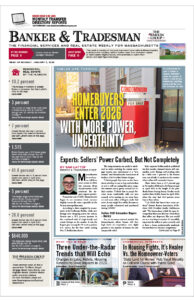
Whether it’s affording consultants fees or having to take hits on bond portfolios that have lost their value since the pandemic, small banks are facing high costs in seeking scale through mergers. iStock illustration
So far, 2025 appears to be bearing out bank executives’ predictions that this would be a good year for M&A.
But upfront costs could be a drag on bank combinations by limiting the ability of smaller institutions to merge in the current high-cost environment, according to Massachusetts bankers.
The last six months have seen a flurry of transactions including the tie-up of Reading Cooperative Bank and Wakefield Co-Operative Bank, Eastern Bank’s acquisition of HarborOne, and Homefield Financial Group’s North Shore Bank buying Colonial Federal Savings Bank.
And Thursday, Needham Bank announced it was buying Amesbury-based BankProv.
But small banks that want to merge face obstacles.
The cost of doing business has increased and the economy appears to be still searching for its footing after early uncertainty caused by President Donald Trump’s tariff policies. While legal, accounting and administrative costs can be estimated, balance sheet costs have been impacted by elevated interest rates.
“An acquirer is required to pay fair market value for the balance sheet of the acquired company,” Hometown Financial Group President and CEO Matt Sosik said. “There’s certain assets that are always marked to market on banks’ balance sheet and others that have a sort of hidden impact.”
If a bank has a large portfolio of mortgages with 3 percent interest rates from the COVID-19 pandemic, for example, the acquiring party will now have to pay current interest rates – double or more what they were five years ago.
“When you do that over an entire loan portfolio, an investment portfolio, or over an entire bank’s balance sheet, it can become a big number,” Sosik said. “That cost of a transaction today is what really is one of the most impactful drivers of M&A activity in banking right now, meaning one of the most clear governors that’s keeping it suppressed because I think there’s a lot of pent-up demand.”
The Lure of Long-Term Benefits
But depending on the merging institutions, it’s not always so cut and dried, said Thomas Senecal, CEO and chairman at PeoplesBank.
“As interest rates are high, there’s less price to be paid because of the decreased value of the acquirers, so to speak,” he said.
Various upfront costs like these can be a barrier to smaller institutions seeking scale, but if they are able to afford the financial hit, there can be long-term benefits.
“What you do need to get through is all of the acquisition accounting and thinking about what costs are going to come over, whether or not costs are actually going to be taken off the table at a closing when you do the combination,” said Julieann Thurlow, president and CEO of Reading Cooperative Bank. “A lot of that planning that needs to happen does usually involve a consultant, and those are upfront costs.”
And when mutual banks merge with each other, they have an easier time absorbing any financial hit. Of the mergers announced over the last 18 months, five have included either a mutual holding company merger or had a mutual bank as an acquirer.
“When it comes to that, mutuals can absorb that over longer term than a stock bank. Stockholders are usually more demanding of a return within a three-to-five-year window, and mutuals can usually push it out a lot further,” Senecal said.
Pressures Won’t Go Away
If they can pay the price to merge, financial institutions can gain access to a lot of benefits that might make a merger worthwhile in the long run: increased deposit pools, and cost savings on personnel, compliance and technology fees due to increased scale.
“There are so many things that are duplicated,” said Thurlow. “We both have two cores. Outside of human costs, the cost of people and staff, the second largest cost is the computer system that we operate with. We have internal auditors, external auditors, security systems, you name it, all of those things become cheaper at scale.”
Some bankers say that could spell a reduction in the unusually high number of banks per person in Massachusetts. Half the state’s 98 FDIC-insured banks have less than the $1 billion in assets many bankers said had become the minimum for long-term survival by the lates 2010s, according to fourth-quarter 2024 FDIC data, the most recent available.
“You still have to have the same level of compliance at a $300 million bank that you do at a $4 billion bank. You’re competing for that talent, and that talent is expensive,” Senecal said. “I think the smaller banks, as these costs continue to rise, and if banks aren’t growing, they’re starting to look for merger partners. I’m hearing it more and more. I’ve never, never heard it as much as I have in the past four years. They’re struggling with keeping up with those costs.”

Sam Minton
Hometown Financial’s Sosik said he believes that if interest rates were to drop, bank M&A activity could increase.
“The underlying forces that are driving the need for consolidation and banking, I believe, will be there for the long term,” Sosik said. “That high cost burden of the interest rate marks on acquired balance sheet: I don’t think that’s going away, either. I think that will continue to be a governing force that regulates the speed of that consolidation, but the forces that are driving the consolidation, I don’t see those going away. So, if rates did fall, there’s your catalyst.”





